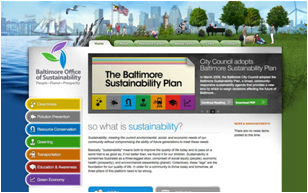Post-Industrial Baltimore
Baltimore is often called a “post-industrial” urban region. What set of cultural and theoretical assumptions does this label invoke? The industrial and post-industrial tag emerges from the Modernist program and discontent with it.
What is Modernism?
 |
|
| The industry window at Zion Church |
The cultural program of Modernism, which like any cultural program is a mix of theoretical assumptions, assertions of boosters, and a vernacular mythology, is a view that held sway from the late 19th through mid-20th centuries. Modernism involves assumptions that progress, driven by industrialization and urbanization, improve society and result in a sequence of development. At the pinnacle of that development was the north temperate, industrial metropolis. Although initial examples of industrial development led to dangerous, polluted, and disease ridden settlements, the leavening of progressive urban reformers in the late 19th century ushered in the “sanitary city.” The sanitary city ideal mitigated the ills of the industrial city, and is most often what people think of when they envision a “modern” city. Such cities suffer less from local pollution, treat wastes released downstream and downwind, provide effective infrastructure for transportation and sanitation, and ideally contain some natural amenities for the benefit of citizens, for example.
Discontent with Modernism
There are at least two problems with the Modernist development model. One is that there has proven to be something “after” the modern. Of course that doesn’t mean something beyond time, but it does suggest that the development model has shortcomings. The Modernist, industrial city was assumed to be the epitome of national and regional development. Perhaps people thought that once achieved, such a modern city would persist indefinitely. Now it is clear that is not the case. Industrial, sanitary cities in many north temperate regions have retreated from the high economic activity, population density, and investment in infrastructure and buildings that they enjoyed at their zeniths. Former industrial powerhouses in the Midwestern and Northeastern US, or in eastern Germany and Europe, have slipped in size, productivity, and prestige. They have become post-industrial.
An Opening for Sustainability
 |
| Baltimore City’s Sustainability Website |
Of course, the wisest cities, including Baltimore, are poised and actively attempting to take advantage of this shift as an opportunity to become more sustainable and to provide an attractive and safe social, economic, and biophysical environment for old and new citizens. So there can be positive outcomes of the shift from the industrial ideal.
Global Failure of Modernism
The second shortcoming of the Modernist development model is its application on the global scale. It appears in the damning phrase, “developing country.” This application seems to assume that all human settlements will evolve through some deterministic sequence, for example, from bucolic agricultural commodity markets, through raucous trading centers, and ultimately to efficient industrial production machines. Associated with this shift is the human demographic transition, in which the initially high birth and mortality rates associated with more agricultural life styles are gradually replaced by low birth and death rates per capita with improved sanitation, medical care, access to education, and the shift from farm to diverse forms of industrial labor.
 |
| A Capetown, South Africa township. |
The assumptions of deterministic development seem to poorly match the reality in many parts of the world. Northern hemisphere industrial and labor development in fact exploited locally equable climates, abundant water for drinking, power, and transport, and drew on resources and people from elsewhere. In particular, industrial production continues to draw on globally distributed oil, gas, and now even biomass stocks. Do the “developing” countries have access to this kind of resource base? By what vulnerabilities are settlements in the Global South, located as they often are in arid and semi-arid regions, or low lying coastal zones, constrained? Are contemporary populations in the “developing” world fixed or mobile relative to regional economic opportunities? The differences, some just now emerging, between the tidy model of development derived from the Global North, and the novelty and diversity of motivations and forms of urbanization in the Global South, suggest that the Modernist narrative, and the mercantile to industrial to sanitary city transition, has limits in understanding urbanization as it now exists throughout the world.
Understanding Urbanization without Modernism
Our post-industrial city, and improved understanding by comparing it with the diverse forms, social, and ecological implications of urbanization throughout the world, can both benefit by acknowledging the limits of the Modernist development model. Our participation in the Research Coordination Network for Urban Sustainability is one tool to advance the theory and practice of urbanism without recourse to the Modernist conceptual and political model.


